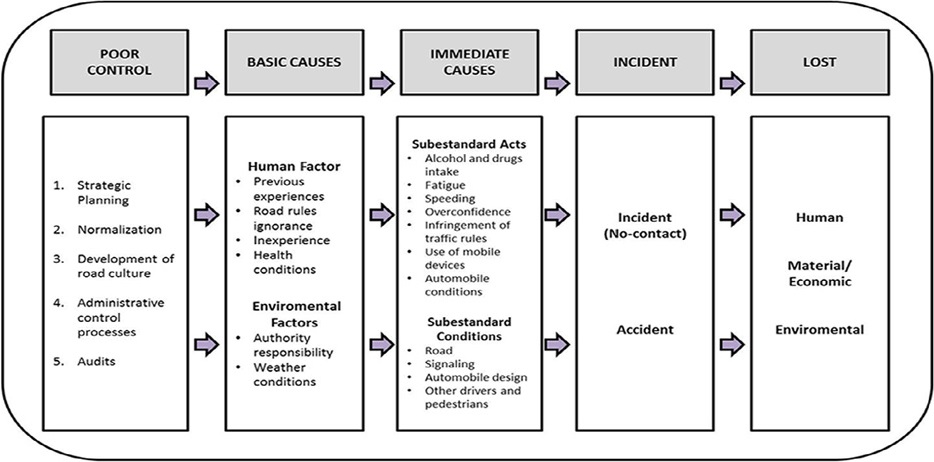Services on Demand
Journal
Article
Indicators
-
 Cited by SciELO
Cited by SciELO -
 Access statistics
Access statistics
Related links
-
 Similars in
SciELO
Similars in
SciELO
Share
Estudios fronterizos
On-line version ISSN 2395-9134Print version ISSN 0187-6961
Estud. front vol.18 n.36 Mexicali May./Aug. 2017
https://doi.org/10.21670/ref.2017.36.a01
Artícles
Road accidents rate in the northern border of Tamaulipas. The approach on the administrative control processes
a Universidad Autónoma de Tamaulipas, Unidad Académica Multidisciplinaria de Matamoros, México, correos electrónicos: yovelazquez@docentes.uat.edu.mx, bzamorano@docentes.uat.edu.mx, luruiz@docentes.uat.edu.mx
The objective of this study is to identify the failures in the administrative control processes that favor risky behaviors in the operators of motor vehicles. Through the analysis of the context of the northern border of Tamaulipas and the most recent accident rate statistics, complementing it with an exploratory study done with a sample of 535 subjects, identifying issues associated with the deficiencies of said processes, and having as limitation the fact that the variables are inherent to the geographic context, it was found that the main causes of road accidents in the municipality are the risky behaviors of the vehicle operators; moreover, there are failures in the administrative control processes, which favor these behaviors. Information is provided to carry out interventions regarding public health and, to conclude, evidence is provided on the existence of differences in the administrative control processes on road safety that favor the risky behaviors of the drivers.
Keywords: accidents; roads; risk; system; Tamaulipas border
El objetivo del presente estudio es identificar fallas en los procesos administrativos de control que favorecen las conductas de riesgo de los operadores de vehículos. Mediante el análisis del contexto de la frontera norte de Tamaulipas y las estadísticas más recientes en siniestralidad vial, complementado con un estudio exploratorio en una muestra de 535 individuos identificando problemáticas asociadas a la deficiencia de dichos procesos y teniendo como limitación que las variables son las propias del contexto geográfico, se encontró que la principal causa de los accidentes viales en el municipio son las conductas de riesgo de los conductores de vehículos; así mismo, que existen fallas en los procesos administrativos de control, las cuales favorecen estas conductas. Se aporta información para realizar intervenciones sobre la problemática de la accidentalidad vial que es considerado un problema de salud pública y, como conclusión, se evidencia que existen deficiencias en los procesos administrativos de control sobre vialidad que favorecen las conductas de riesgo de los conductores.
Palabras clave: accidentes; vialidad; riesgo; sistema; frontera de Tamaulipas
Introduction
Car accidents have become a public health problem worldwide (Alfaro-Basso, 2008). According to the World Health Organization (WHO) (Organización Mundial de la Salud [OMS], 2015b), these events cause the death of approximately 1.25 million people around the world annually, being the most affected those between the ages of 15 to 29 years of age. This figure has been constant throughout almost 10 years. In this regard, the General Board for Road Traffic of the Municipality of Ciudad Juarez, Chihuahua, Mexico (Dirección General de Tránsito Municipal, n.d. ), states that in the region of the Americas, around 5 million people are injured as consequence of road accidents. In addition, this is considered the primary cause of death for people between the ages of 5 to 14 years of age and the second leading cause of death for people between the ages of 15 to 44 years of age in said region. Furthermore, “the countries of Latin America and the Caribbean almost double the death rate due to road accidents of the developed countries” (Gallego et al., 2015, p. 1).
There seems to be a direct relation between the economic characteristics of the nations and the mortality rate due to traffic events. According to the figures of the WHO’s global situation report on road safety (OMS, 2015a), of a total of 163 countries, 68 recorded an increase in the amount of fatalities due to road accidents since 2010, 84% of which corresponded to countries with low or average income. Of the 79 countries that recorded a decrease in the number of deaths due to this, 56% corresponded to nations with low and average income. Nevertheless, the mortality rates of countries with low income represent more than double the amount of those recorded in countries with high income. On the other hand, even though 90% of deaths caused by road accidents are distributed among the countries with low and average income, these comprise only 54% of the existing vehicles in the world.
In a national context, according to figures by the Health Sector Program (Programa Sectorial de Salud, 2014), in 2012 there was an increase of 29.3% in deaths related to road accidents in Mexico when compared to the previous year. In this sense, the Secretariat of Health (Secretaría de Salud [SS]), 2012) manifests that, in the country, car accidents are the cause of death of around 24 000 people annually, occupying the seventh place worldwide in road accidents. In this context, since 2009, Mexico has held the tenth position in the number of deaths caused by road accidents out of a total of 32 countries (Cable News Network México [CNN México], 2014).
In 2012, the mortality rate due to road accidents resulted in 14.6 deaths for every 100 000 inhabitants, whereas in 2014, 378 240 road accidents in the urban areas of Mexico were recorded, 1.1% of which resulted in fatalities with a total of 4 708 victims, 43% of which corresponded to the drivers of the vehicles involved (Instituto Nacional de Estadística y Geografía [Inegi], 2015). In this sense, the trend towards the increasing statistics on road accidents and their consequences has been projected for more than a decade. Cabrera, Velásquez and Valladares (2009) claim that for 2002, the nations that reported violent deaths to the WHO, determined road accidents as the common cause of the same. The deaths related to these events represented 23% of the total of casualties. Regarding the age groups, the deaths derived from road accidents were the second cause of said fatalities in children and pre-teens (5-14 years of age), and in teenagers and young adults (15-29 years of age), as well as the third leading cause of deaths of adults between 30 and 40 years of age. For 2013, road accidents already affected 2.2% of the global population (CNN México, 2014).
Moreover, in a study carried out by Arreola, Guzmán, Esquivel and Mock (2008), it was found that in the state of Nuevo León two thirds of the deaths associated with this phenomenon, recorded during the period of February to July, were of those inside the vehicles.
It is worth pointing out that the losses caused by road accidents are not limited to human integrity alone, though this could be the most important consequence. Alemany, Ayuso and Guillén (2013), highlight the financial repercussions that these accidents entail. In this respect, Aguilar-Zinser (2010) states that, according to the Organization for Economic Cooperation and Development (OECD), the costs due to road accidents among the member nations are calculated to be between 2 and 5% of the Gross Domestic Product (GDP), whereas in Mexico, according to the data presented by the Health Sector, it is 1.3% of the GDP. According to the figures of the Secretariat of Health (SS, 2012), this percentage represents almost 130 000 million pesos per year allocated to the immediate medical attention of the emergency services provided to the injured, subsequent medical treatments, and material and physical damages.
This is how road accidents represent high costs to the health dependencies. The WHO (cited in Ávila et al., 2008) confirms that for each person who dies as consequence of these events, on average 30 people are hospitalized, while 300 others need to get medical treatment in the emergency units. Furthermore, around 43% of these take around a year to recover.
On the other hand, if the victims are children, the “repercussions are not limited to the loss or damage of one organ, but also entail the interruption of their development, with consequences that could last a lifetime” (Bustos, Cabrales, Cerón & Naranjo, 2014, p. 69), which also entails expenses for rehabilitation, surgeries, medicine, among others, that many times should be absorbed by the government health departments. According to Kalantar, Dadgar and Ebrahimi (2014), each year there are 20 to 50 million people with disabilities, due to the injuries caused by road accidents. Moreover, these events are the leading cause for maxillofacial fractures.
The situation is truly alarming and the future looks grim. The Pan American Health Organization (Organización Panamericana de la Salud [OPS], 2013) expresses that there is a high probability that the trauma related to road accidents will increase for the year 2030, thus becoming the third leading cause of death. However, despite the available information in this regard, the WHO (2013) attests that the road accidents that cause non-fatal injuries, are poorly documented.
In view of the foregoing, it is important that the investigations focus on the identification of the risk factors present in road accidents. Nevertheless, it is worth mentioning that, according to Vázquez (2004), the factors associated with a road accident are varied, hence the complexity of his study, as said accidents derive from multiple causes that are not always correctly identified.
Although these events present themselves for multiple causes, which are generally combined together, if it is taken into consideration that a high percentage of road accidents in the world are attributed to the human factor (Alfaro-Basso, 2008; Arias 2011), whose behavior regarding road safety is determined by their “training, experiences and values” (Adriasola, Olivares & Díaz, 1972, p. 12), then it becomes a priority to address these from this perspective, so that the efforts are aimed towards the elimination of risky behaviors (WHO, cited in Morales-Soto, Alfaro-Basso & Gálvez-Rivero, 2010).
Nevertheless, while it is true that risky behaviors are constantly present in the occurrence of road events, these can only be considered as the immediate causes before the accident, but not as the root cause. According to Cortés (2001), when there are deficiencies in the administrative exercise these could generate a series of consequences-actions and conditions-that trigger accidents.
It is due to the above that this research work is done. Its goal is to detect the failures in the administrative control processes that could negatively impact the behaviors of vehicle drivers in the city of Heroica Matamoros, Tamaulipas, Mexico. In this manner, it is our motive to contribute with significant information that will help the competent authorities fulfill the first objective of the Health Sector Program (Programa Sectorial de Salud, 2014, p. 43), in the corresponding section of road safety: “the generation of data and scientific evidence for the prevention of injuries caused due to road accidents”.
For this, the following hypotheses are considered:
The main cause associated with the occurrence of road accidents in the municipality of Matamoros, Tamaulipas, corresponds to the risky behaviors of the drivers, who risk both their integrity and that of third parties.
In the city of Matamoros, Tamaulipas, there are failures in the administrative control processes, which represent a risk factor associated with road accidents, as they favor risky behaviors.
Risk factors associated to road accidents
It should be clear that, as long as the timely and correct identification of the risk factors associated to road accidents is done, it is then possible to speak of taking effective actions regarding the prevention, elimination or control of risk situations, thus reducing the negative impact that these events carry health-wise, socially and financially.
When speaking about a risk factor, we are referring to a condition, circumstance, action or omission that increases the probability of occurrence of an undesired event, in this case, an accident. According to Heinrich (cited in Meliá, Ricarte & Arnedo, 1998), an injury is the result of a sequence of factors wherein the last of them is the accident itself.
Some of the risk factors that have been associated to road accidents are related mainly to the driver, such as:
Excessive speed (Pérez-Núñez, Híjar, Celis & Hidalgo-Solórzano, 2014).
The intake of alcohol and drugs (Calafat, Adrover, Juan & Blay, 2008; Dirección General de Tránsito Municipal, n.d.; Guanche, Martínez & Gutiérrez, 2007; Pérez-Núñez et al., 2014).
Risky behaviors (Morales et al., 2010; Sánchez, 2008).
Exhaustion-fatigue (Rey, González & Egoavil, 2009; Rosales et al., 2009), and
The use of cell phones when driving (Pérez-Núñez et al., 2014; White, Hyde, Walsh & Watson, 2010).
Other road conditions-it is considered that the risks associated with the roads is higher in underdeveloped and developing countries- (Medina, Borja & Flores, 2014), conditions of the vehicle and factors associated to the weather (Roth, 2016), have been present in the investigations of this subject to a lesser extent.
For Perrow (cited in Godoy, Escaudar, Jaca & Pinto, 2001), risk situations seen at the individual level or at the level of a group of individuals, are really a problem of organizational structure. This author attributes the occurrence of accidents as consequence of the complexity of the system.
This approach is similar to the theory of multicausality designed by Bird and Germanin (1990), which departs from the premise that the origin of work accidents (losses) is the lack of control in the administrative processes (Figure 1).
Even though this is an old theory, it remains in force, as the strategies geared towards the administrative controls for the prevention of risks represent an activity that is presently still in motion in the work spaces.
In this model, the lack of control in the administrative procedures and programs is identified as the root cause that triggers a series of events that end in a loss (accident), be it financial, health related or both. For the case of this study, work factors will be replaced by environmental factors (road, signaling, weather), which are what would cause the sub-standard conditions faced by the driver on the road. This includes the design and construction of proper roadways (including lighting), which should preferably be considered from the planning stage. However, it is common that in this stage, important conditions for the safety of both the driver and the rest of the road users are overlooked. In this case, the modification of some of the conditions to decrease the risk for accidents ought to take place. However, as indicated by Quistberg, Miranda and Ebel (2010), in several occasions these modifications imply the realization of significant changes both regarding the roads and the physical environment, which entails a considerable investment that makes their implementation less attractive to the corresponding authorities.
According to the theory of Bird and Germain (1990), the administrative processes correspond to the authority, which will be the one to ensure that the programs are adequate, that they contain the relevant standards and that they are complied, delivering the corresponding financial or administrative punishments in a timely fashion, thus preventing the impunity of undesired events and therefore decreasing their occurrence.
In other words, the administrative control processes, whether they are efficient or deficient, establish the tendency of the social environment, which indirectly influences the behavior of the individual. Donas (2001), explains that the individual is influenced by the multiplicity of the risk and protection factors with which he interacts at different moments in time, making him more or less vulnerable to damage as a consequence of an acquired behavior; for example, not using safety devices when driving.
Even though the public administrative processes are not considered a risk factor associated with road accidents in the majority of investigations, there is work such as that by the National Committee for the Prevention of Accidents in Highways and Roads (Comité Nacional de Prevención de Accidentes en Carreteras y Vialidades [CONAPREA] cited by Mendoza, Quintero & Mayoral, 2003), which identifies the system as one of the four main factors that should intervene in the prevention of road accidents, within which the strategic planning aspects are included.
In this sense, Ferrer, Smith, Espinosa, Cuellar and Raffo (2013), state that, according to an analysis of the road safety management capacity in Colombia, a weak point that needs to be addressed is the system in terms of its lack of coordinated actions among the different authorities to promote a favorable behavior on the drivers regarding regulatory compliance. Furthermore, the system for the issuing of driver’s licenses and vehicle approval proved to be deficient.
In this regard, Planzer (2005), has found that in the context of Latin America and the Caribbean, the lack of attributions is a problem reported by most of the countries and he considers that the opinion of the entity dedicated to road safety should carry some weight on decisions regarding the penalty system, the issuing of driving licenses, traffic regulations, among others, so that administrative decisions are more justified and not made unilaterally. In addition to the foregoing, the control measures implemented need to be built on a realistic assessment of the situation in the country regarding road safety, in order to determine the actions to be taken for the achievement of the goals and objectives proposed. For this, it will be necessary to take actions such as those mentioned by Arreola, Herrera, Cruz and Mock (2003), with regard to having an information system on the registry and the monitoring of the different offices, such as road agents, public and private hospitals, prosecution authorities, among others.
These records should not only be limited to injuries or losses, but also collect information about their causes.
Starting with the idea that, even if the causality model of losses was generated from a work approach, it is not exclusive to it and that in the case of road accidents the failures in the control process originate from the management level, the administrative control processes regarding road safety represent a factor that ought to be considered within the multicausality of road accidents. This does not mean that the system itself is responsible for the occurrence of these events; however, the impact on the possibility of a human mistake will be considerable in the extent that the activities derived from the system are efficiently controlled.
Geographical context
Tamaulipas is a state of the Mexican Republic located on the banks of the río Bravo, to the northeast to the country. It borders to the north with the United States of America and is divided into 43 municipalities. It ranks number 13 in the Mexican Republic in terms of its number of inhabitants, with a population of 3 268 554 people, 50.5% of which are women and 49.5% are men, according to the figure of the Inegi (2010).
During the period of 2012-2013, the mortality rate for road accidents in the entity remained above the national average, with values of 16.2 and 15.3 respectively, as shown in Figure 2.
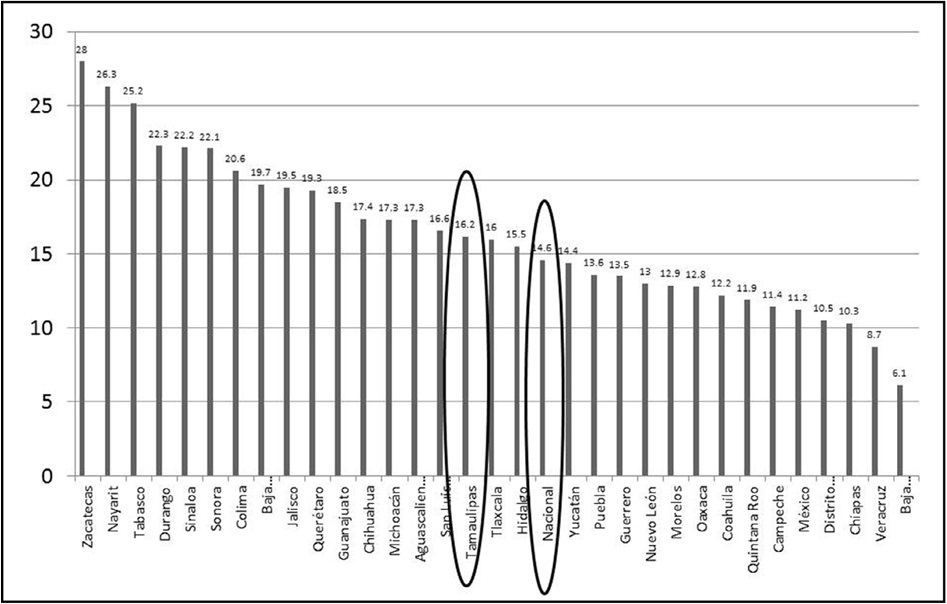
Figure 2: Graph presenting the mortality rate due to injuries caused by road accidents in the federative entities, Mexico, 2012-2013
Furthermore, during 2014 the mortality rate was of 15.4, which represented an increase of 1.3%, remaining above the national average (SS, 2015). The mortality rate is one of the indicators of road safety that ought to be monitored by all the levels of government; however, it is not the only one, as not all traffic accidents end in death.
Within the entity, the three municipalities that represented the highest frequency of road accidents during the year 2014 correspond to the border cities, as observed in Table 1.
Table 1: Municipalities with a higher incidence of road accidents in Tamaulipas, 2014
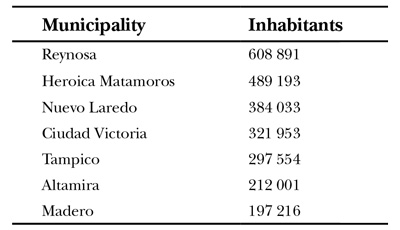
Source: Inegi, 2015.
The geographical location of these municipalities is shown in Figure 3.
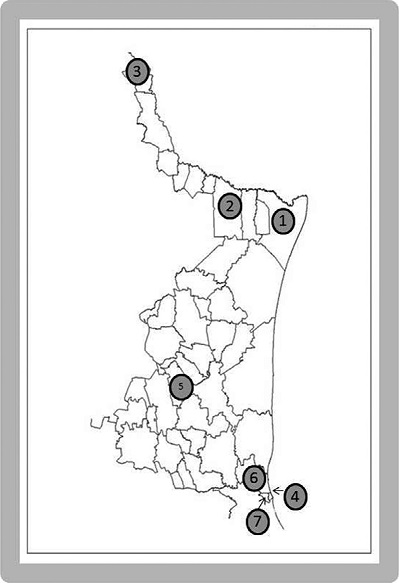
Figure 3: Geographical location of the municipalities with the most road accidents in Tamaulipas, 2014
Although it could be thought that the amount of accidents is correlated to the number of inhabitants of each municipality, this is not entirely correct, given that in the last population and housing census of the Inegi (2010) (See Table 2), the number of inhabitants of these municipalities was the following:
Table 2: Distribution of the population by municipality, 2010
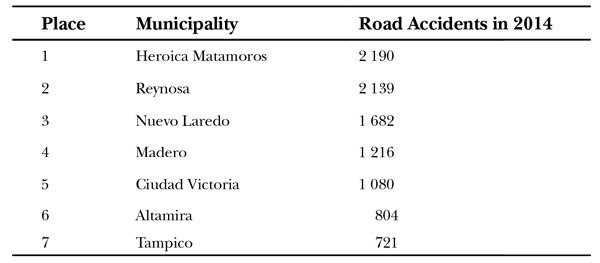
Source: Own elaboration based on data from the Inegi (2010).
In this sense, with the population of Matamoros being smaller than that of Reynosa by more than 100 000 inhabitants in 2014, it surpassed the latter with 51 vehicular accidents, so that the rate of road accidents per 100 000 inhabitants was of 351.29, whereas for Matamoros it was of 447.67.
Regarding the three municipalities with the highest occurrence of road accidents within the entity, they are all located on the upper limit of the state, bordering to the north with the south valley of Texas. Due to this, another common characteristic between them is the constant presence of foreign vehicular and irregular traffic, of which there is no official record. According to the figures of the National Institute of Ecology and Climate Change (Instituto Nacional de Ecología y Cambio Climático), the number of vehicles registered in Matamoros before the Ministry of Finance is 76 533 while in the “Final report of issuance and vehicle fleet of Matamoros and Reynosa Tamaulipas” the number of active vehicles is 267 290 (cited in Zamorano, Peña, Parra, Velázquez & Vargas, 2015).
In this respect, the Mexican Association of Automotive Industry (Asociación Mexicana de la Industria Automotriz) estimates that in 2001, around 1.5 and 2.5 million not legalized vehicles circulated in the country (Martínez, 2012). The significant difference between the figures is due to the impossibility of having a reliable census of these vehicles. Unofficial data from different sources have calculated that more than 100 000 foreign vehicles circulate in some cities of this border area. This tendency derives from the acquisition accessibility of foreign cars in comparison to Mexican cars. The main problem with this, is that even though there is the alternative of regularization and, in some cases, to nationalize them and thus legalize them, the costs of these processes are elevated, and as there is no real consequence for driving unregistered vehicles. The owner assesses the cost-benefit, concluding that it is cheaper to pay an administrative fine and even lose the vehicle, than to pay for the legalization of it and for car tenure tax. In this sense, it is important to point out that this situation represents a potential risk factor in the recurrence of road accidents, due to the fact that when the driver breaks a traffic law or causes an accident and flees then there is no way to track him, as even if there is knowledge of the number of the license plates, these are not registered in Mexico and thus cannot be connected to the owner of the vehicle, they may even be superimposed. In this manner, the possibility of the offence going unpunished and being repeated increases.
This situation can be observed even in public transportation in Matamoros, specifically on taxis that circulate freely in the city-unofficial figures mention more than 300 vehicles, distributed in different bases. Unfortunately, it is common to see how the drivers of these illegal vehicles often act recklessly, putting themselves and other road users at risk.
Another common factor is the instability that exists regarding the road safety elements, as due to the social context of the state since a few years ago, traffic police show up on the road intermittently, sometimes letting months go by without their presence on the streets. In other cases, these attributions are assigned to other entities such as the military or the state police, the main roles of which differ from that of monitoring compliance with road regulations.
Materials and methods
There is undeniably a great diversity of research works that address the risk factors associated with road accidents; however, information regarding the effectiveness of the administrative control processes is extremely scarce. Even when this subject is addressed in some of them, the data generated are pertinent to other contexts. In the case of the state of Tamaulipas, there are social and political factors that differentiate the entity from the rest of the federative entities of the republic; therefore, we consider this work to have an exploratory design and a quantitative and transversal focus.
The method to obtain data was divided into two stages. The first consisted in the consultation and interpretation of statistical data on road accidents in the state of Tamaulipas and the municipality of Heroica Matamoros for the period of 2005-2015, in urban and suburban areas. According to the Inegi (2009, p. 7), the urban area “is the area inhabited or urbanized which, parting from a central nucleus, presents physical continuity in all directions until it is interrupted in a very clear manner by plots of land of non-urban use such as woods, plantations or bodies of water”; whereas the suburban area refers to the “areas where there is a population of 2 500 to 14 999 inhabitants, houses are scattered and sometimes they even lack some services” (Inegi, 2009, p. 7). The latter includes rural roads and state roads.
In the second stage, a survey was applied to drivers in the municipality in order to confirm, in an empirical manner, if there are failures in the administrative control processes in the city of Matamoros, Tamaulipas, regarding road safety, which could favor risky behaviors on behalf of the drivers.
The study population has the following characteristics:
Be the driver of a vehicle-specifically a car-in order to obtain data on the exercise and experiences of the subject as a driver.
Live in the municipal capital of Heroica Matamoros, Tamaulipas, this being the site under study.
Be between the ages of 18 and 26, considering that in Mexico road accidents are the second leading cause of death in young adults, with the people inside the vehicle being the most affected (Inegi, 2012).
The subjects of the sample were selected through a non-probabilistic and convenience sample. In this manner, the sample was comprised by 535 university students.
The collaboration of the people from the sample was voluntary, under the guarantee of anonymity and confidentiality in the research process. The instrument used was a questionnaire, which comprised 15 items, 2 of which were related to their demographic characteristics and the remaining 13 to the study variables. The questions were designed with closed, dichotomous answers.
The validation of the instrument was done through a construct, with information obtained from a previous pilot test on a total of 120 students. The variables were classified into two categories: 1) Variables related to the administrative control processes, and 2) Variables in terms of the human factor (driver).
The reliability of the questionnaire was calculated through the KR 20 coefficient, obtaining a value of 0.775.
Nevertheless, the impossibility of establishing a precise correlation between the data found and the road accidents recorded by the official dependencies of the municipality is highlighted due to the following limitations:
The existing databases regarding road accidents in the location do not have precise information concerning the causes of the same.
In the health department of the location, the causes of the injuries due to road accidents are not recorded.
In the reports of road accidents generated by the local traffic department, only the immediate and obvious causes are recorded and not the risk factors associated to the administrative control processes.
The formats for road accidents used by the departments that participate in their recording are not unified and are not fed into a single database, thus the information is disperse and is sometimes not available for consultation.
According to Planzer (2005), this problematic is common in developing countries. These countries lack collection and processing methods for the data on traffic, and therefore the reported statistics are usually incomplete, which hinders the analysis of information for the taking of effective actions for the prevention of road accidents.
Results
First stage
The main road safety indicators in the entity and the municipality are presented below. This information has been obtained mainly from the databases of the Inegi, as it is the institution responsible for the concentration of these data at a national level, which is obtained from the information of the General Boards for State Road Traffic and the Municipal Traffic Departments. It is worth mentioning that the figures that correspond to the year 2015 are not final.
Indicators of road safety in Tamaulipas and Matamoros
In Table 3 we can observe that road accidents in the entity have gradually decreased during the second half of the period when compared to the first half. However, in 2015, we can observe a significant increase in road accidents when compared to the previous year, both in the state and in Matamoros, which represents an increase of 3 030 and 1 349 accidents, respectively. On the other hand, the percentage of road accidents in Matamoros in relation to those recorded in the entity increased in the last five years. This is worrisome if we also consider that only the accidents recorded by the official departments are taken into consideration, which means that the number of road accidents is probably considerably higher if we were to consider the accidents that are not reported. Furthermore, in the state, more than 93% of the accidents have been recorded in urban areas, whereas in Matamoros it has been more than 98%.
Table 3: Road accidents in Tamaulipas and Matamoros, by area
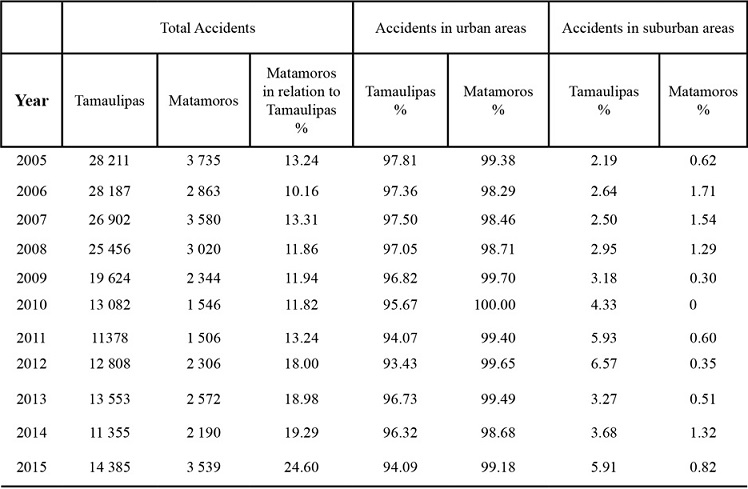
Source: Own elaboration based on statistics from the Inegi (2015).
As shown in Table 4, even if there is a decrease in road accidents in the entity, the percentage of deaths due to the same has increased during the second half of the period, particularly during the years 2010 and 2014. On the other hand, regarding the percentages of fatalities in the municipality concerning those that took place in the state, it can be observed that the lowest percentage was in 2009, however, in 2015 the number of deaths recorded for this cause is almost three times greater. It should be noted that these statistics refer mainly to the deaths that occurred at the site of the accident and not those that occurred after as consequence of the same. This is due to the fact that there are no databases where the follow-up information is integrated, thus allowing a closer approximation to the reality of this situation; it is, therefore, highly probable that the number of deaths by road accidents is greater.
Table 4: Road accidents by type of accident
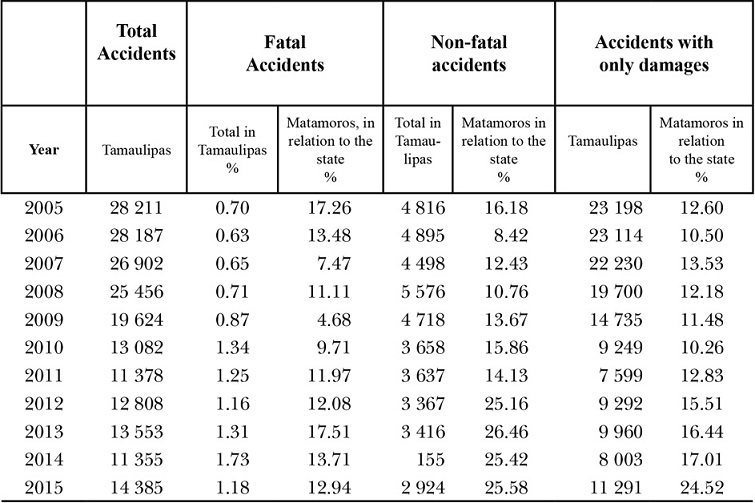
Source: Own elaboration based on data from the Inegi (2015).
Concerning non-fatal road accidents, while in Tamaulipas the number of these accidents tends to decrease; it can be observed that since 2008 there has been a gradual increase in the percentage of those recorded in the municipality, so that in the period of 2012 to 2015, the non-fatal accidents occurred in Matamoros represent more than 25% of the cases recorded in the entire state. In this regard, it is important to clarify that there are cases where the driver responsible for the accident flees the scene, which implies that his injuries and those of the people with him are not always recorded in the statistics.
Lastly, the road accidents that result in only material damages showed a downward trend in the state, with the exception of 2015, when there was a significant increase in relation to the previous year with 3 288 more cases, almost 25% of which correspond to the municipality of Matamoros. Similarly, the year 2013 presented the highest percentage of fatalities and non-fatal accidents in Matamoros with regard to the total recorded in the state, within the period of the study.
As shown in Tables 5 and 6, the cause that has been mainly identified in road accidents both in the state and in the municipality, correlate to the driver of the vehicle. Regarding the fatal accidents in Matamoros, this cause is the only one recorded in the years 2005, 2006, and 2008 to 2011, while in Tamaulipas it is greater than 90% for the last three years of the study period.
Table 5: Road accidents in Tamaulipas, by cause
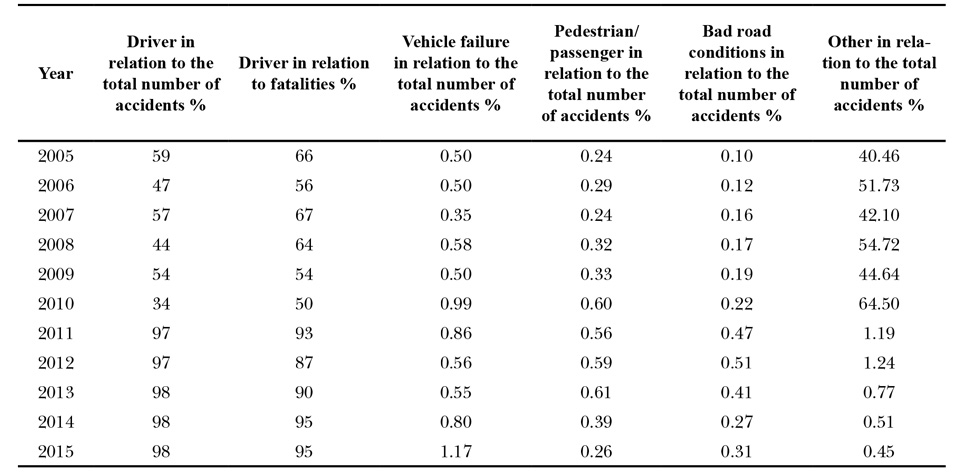
Source: Own elaboration based on the data recorded by the Inegi (2015).
Table 6: Road accidents in Matamoros, by cause
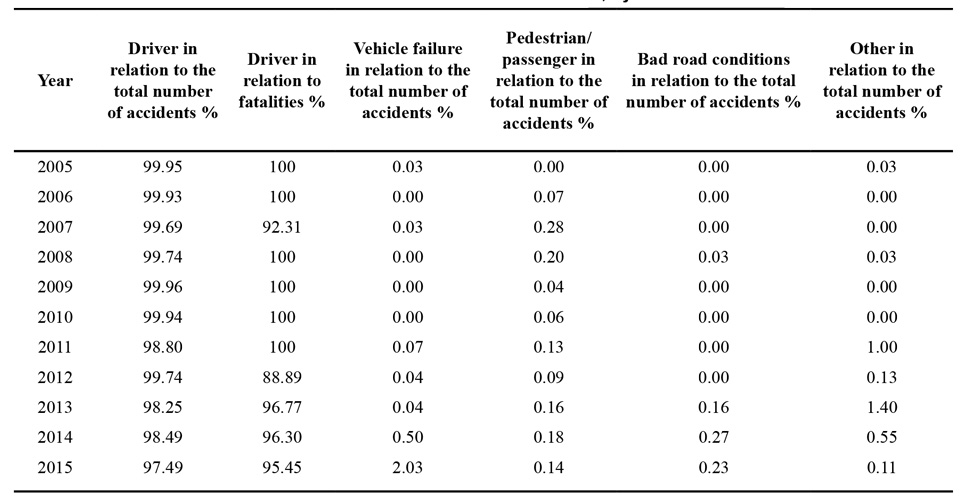
Source: Own elaboration based on the data recorded by the Inegi (2015).
Regarding the types of accident, the main three are: 1) collision between vehicles, 2) collision with fixed objects, and 3) collision with pedestrians. It is worth pointing out that the first is greater than 60% in both cases. On the other hand, even though the collisions with motorcycles are not among the first three types of road accidents, it is noteworthy that the percentage of these accidents has increased in Tamaulipas, from an initial 1.40% to 6.10% at the end of the period, whereas in Matamoros it went from 1.07% to 3.19%.
With regard to the fatalities caused by road accidents in the state, the most frequent type of accident at the start of the study period was the collision between vehicles, followed by collisions with pedestrians and overturning accidents. While in the second half, collisions with pedestrians represent the leading cause of death. Concerning the municipality, in the last five years, the type of accident identified in the case of most deaths has been the collision with pedestrians, followed by collision between vehicles, with the exception of 2015, year during which collisions with a fixed object took first place.
Second stage
The following is the data obtained in the application process of the questionnaire regarding the demographic characteristics of the sample and their distribution. Fifty-three percent of the participants are male, while 47% are female. Regarding age, 33% of the sample can be found in the range of 18 to 20 years of age, 18% between 21 and 23 years of age, and the remaining 49% between 24 and 26 years of age.
In terms of the characteristics of the sample in the driving exercise, 88% have 1 to 5 years of experience as drivers, while 81% of the sample stated that the approximate number of times they drive in a day is 3 to 4; however, only 66% of them have a driver’s license and of this percentage, 15% do not have a valid license.
In addition, of the 353 youth that have obtained their driver’s license, 105 of them (30%) stated not having taken a driver’s course prior. It is worth noting that even though 70% of these young people stated having taken driving lessons, the reality is that presently there is no certified driving school in this location, and if lessons were taken it might have been through informal methods with non-accredited people, without a guarantee for the correct implementation of traffic regulations. Furthermore, 50% of the young people surveyed stated not taking a theoretical or practical exam prior to the acquisition of their driver’s license. Likewise, 98% said they had not had a medical examination to rule out vision problems before starting their driving exercise as a requirement to obtain their license.
On the other hand, it is important to point out that, even though 48% of the respondents affirm that they have not violated any traffic regulations, 62% of the participants indicated not knowing the traffic regulations of their city. This means that some people could have violated the regulations without being aware of it.
Moreover, 52% acknowledges having violated traffic regulations as a driver at least once in the last couple of months. However, of that percentage, 42% stated not having been fined by a traffic authority when committing said violations.
Similarly, 43% of the sample, that is 230 of the participants, indicated having suffered at least one road mishap while driving within the last three months and in only 40% of these cases did the local traffic authorities intervene. That is, 60% of the events were not filed. Lastly, in 35% of the events that took place, there was at least one foreign vehicle involved.
Risk situations can be identified from the foregoing or, according to Bird and Germain (1990), from acts and substandard conditions that increase the occurrence probability of road accidents, which the corresponding authorities have an influence on. These are described in Table 7.
Discussion
Although road accidents in urban and suburban areas have decreased in the entity throughout the years, the mortality rate due to these events has increased and remains greater than the national average (CONAPRA, 2014; Inegi, 2015). Furthermore, road accidents have significantly increased during the year 2015, both in the state and in the municipality, presenting a greater incidence in urban areas. Similarly, non-fatal accidents and those with only material damages recorded in 2015 represent around 25% of those recorded in the entity.
The main cause associated with these events, in both cases, has been the driver, which is consistent to what was presented by Arias (2011) and Alfaro-Basso (2008). Similarly, the first hypothesis declared in this study is confirmed: “The main cause associated with the occurrence of road accidents in the municipality of Matamoros, Tamaulipas, corresponds to the risky behaviors of the drivers, who put their own integrity and that of others at risk”.
The main type of road accident in the municipality and in the state, is the collision of vehicles; whereas the collision with pedestrians is the number one type related to fatalities during the second half of the study period in both cases. Except for 2015, year during which collisions with a fixed object took first place.
Furthermore, the administrative control processes in terms of road safety in the municipality present serious deficiencies, which is similar to the case of Colombia as indicated by Ferrer et al. (2013). According to the results of this study, the failures detected mainly refer to the issuing of driver’s licenses without the applicants having to confirm their theoretical knowledge and practical skills as a driver, and not ensuring that they are in optimal physical condition, particularly regarding their vision. Another failure is in relation to the lack of control mechanisms that ensure that the driver knows the traffic regulations of the city, so that they are aware of the basic knowledge on the correct use of the roads.
On the other hand, there is also a lack of road surveillance elements to ensure the enforcement of administrative or financial sanctions on the offender, which will help decrease the probability of impunity and thus, the possible reoccurrence of the risky behavior. In this sense, the lack of control regarding the legalization of vehicles creates the proper environment to avoid responsibility in the case of a road accident.
The foregoing helps corroborate the second research hypothesis: “In the city of Matamoros, Tamaulipas, there are failures in the administrative control processes, which represents a risk factor associated with road accidents, as they favor risky behaviors”.
As indicated by Planzer (2005), prior to establishing actions and road safety programs, the regions need to carry out a prior diagnosis that provides real information on the local problems, so that the decision making is done based on accurate information and not mere assumptions. Therefore, the context and the time in which the interventions are done must be taken into consideration.
In the case of the municipality of Matamoros, Tamaulipas, it is evident that behind the human behavior there are deficient administrative processes, as indicated by Bird and Germain, (1990), thus, the system itself ought to be considered as a factor that influences the behavior of the human factor, either positively or negatively. In this manner, the system should be included in the road accident prevention processes as an implicit factor, as presented by the work groups of the CONAPREA (cited by Mendoza, Quintero & Mayoral, 2003).
In this sense, Sánchez (2008) shows that this behavior may be modified through the implementation of an adequate penalty system (perceived sanctioning effect). It is worth mentioning that in Mexico, one of the social problems is corruption, which could represent an obstacle for the effectiveness of the penalty system.
Nevertheless, the long-term goal is the road culture that can be observed in all road users and not just the reaction caused by coercion. The reality is that, to achieve this, the first step should be the implementation of effective control methods to ensure the basic compliance of traffic regulations, which undoubtedly is the responsibility of the public administration.
Therefore, based on the information consulted and the results obtained through the implementation of the questionnaire, we propose the multicausality model of road accidents in Figure 4.
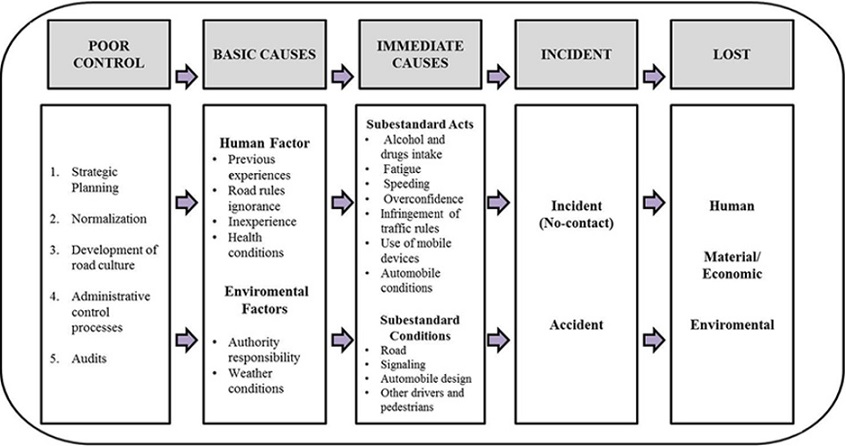
Source: Own elaboration. Adaptation of Bird’s model (Bird & Germain, 1990).
Figure 4: Multicausality model of road accidents
The lack of control parting from the system includes several aspects, such as a) the strategic planning in the construction and distribution of roads; b) the creation or modification of the regulations so that obsolescence is eliminated and legal holes are covered, which increase the possibility of risk; c) the promotion of road culture and education should be a task undertaken by the authorities, as this phenomenon is a process to be addressed together on a daily basis and not only in sporadic campaigns; d) the fine system regarding the financial or legal sanctions that must be implemented as consequence for undesired behavior, as well as the processes that make it possible to have control on the drivers, such as the issuing of driver’s licenses; lastly, e) the audits of the critical items of road safety and the proper operation of the institutions in terms of road safety that help take preventive actions for the reduction of traffic events.
Furthermore, adopting programs that improve the license issuing process is a good option to reduce risks. In certain countries, such as Canada and the United States, the “Graduated Driver Licensing (GDL)” program has been implemented. This system entails that for the first few months of driving, the driver is accompanied by a supervisor, after which an unsupervised driving phase begins, but it is restricted to time slots or spaces where the risk of collision is at a minimum. Subsequently, a license without restrictions is granted. Novoa, Pérez and Borrell (2009) consider that these types of programs have resulted in a 31% decrease in the number of collisions and a 7 to 19% decrease in fatalities.
Similarly, Gómez, Pérez and Hidalgo (2014) state that in countries such as the United States, France, Austria, England and Wales, the decrease of the maximum permissible limits to 0.05 g/dL of blood alcohol levels in drivers has resulted in the decrease of several road safety indicators, particularly regarding fatalities. Whereas in other places such as Australia and the Netherlands, a similar progress is attributed to the advertising campaigns and the rigorous implementation of the legislation.
With such actions, the permanence of conditions inherent to the human factor can be reduced, such as the individual’s perception that they can violate the regulations without fear of punishment or repercussions, having a driver’s license without knowing the traffic regulations of their city, or having visual, auditory and other problems, which increase the risk of suffering an injury or causing an accident. At the same time, it would have an impact on several environmental factors that contribute to the occurrence of these types of events. Therefore, the substandard acts and conditions are reduced, preventing incidents or accidents and the losses that these entail.
If research on road accidents remains at a level that only addresses immediate causes, then we will not have the necessary information to deal with the root cause of the same.
Conclusions
Even if the system-understood as the administrative control processes regarding road safety-is not solely responsible for road accidents, it is indisputable that there is a clear deficiency in its key role, which is to establish effective means of control to reduce the risks associated with road accidents. Specifically, their incidence stems from the human factor, which has been identified as the main cause of said traffic events.
For that reason, it can be said that as long as these processes are effective, their positive impact will be evident in the reduction of road accidents and, therefore, in the health of the population.
On the other hand, it is important to continue the studies on this topic, applying this instrument on more extensive samples and other contexts, correlating the different factors that intervene in the occurrence of road accidents and determining the extent to which they affect the same, so that we are able to delve into the causes and go beyond what is only “the tip of the iceberg”.
However, as long as the research records on accidents are not enhanced and standardized, and there are no complete databases fed by all the dependencies that intervene in traffic events, researchers will continue to face serious obstacles in the procurement of data for their scientific contributions on effective road safety measures.
Referencias
Adriasola, G., Olivares, C. y Díaz, C. (1972). Prevención de accidentes del tránsito. Bol of Sanit Panam, 72(1), 1-18. [ Links ]
Aguilar-Zinser, J. (2010). La situación actual de los accidentes en el mundo. Simposio. Gaceta Médica de México, 146(6), 384-388. [ Links ]
Alemany, R., Ayuso, M. y Guillén, M. (2013). Impact of road traffic injuries on disability rates and long-term care costs in Spain. Accidents Analysis & Prevention, 60, 95-102. [ Links ]
Alfaro-Basso, D. (2008). Problemática sanitaria y social de la accidentalidad del transporte terrestre, Rev. Perú Med. Exp Salud Pública, 25(1), 133-137. [ Links ]
Arias, W. (2011). Una reseña introductoria a la psicología del tránsito. Revista de Psicología, 13(1), 113-119. [ Links ]
Arreola C., Guzmán J., Esquivel, A. y Mock, C. (2008). Traffic related deaths in Nuevo Leon, Mexico: causes and associated factors. Salud Pública de México, 50(1), 48-54. [ Links ]
Arreola, C., Herrera, A., Cruz, O. de la y Mock, C. (2003). Análisis de la mortalidad por accidentes viales en la ciudad de Monterrey. Qué hemos aprendido y estrategias a implementar, TRAUMA, 6(1), 4-14. [ Links ]
Ávila, L., Medina, C., Pérez, R., Híjar, M., Aracena, B., Hidalgo, E. y Palma, O. (2008). Prevalencia de accidentes de tránsito no fatales en México: resultados de la ENSANUT 2006. Salud Pública de México, 50(1), 38-47. [ Links ]
Bird, F. y Germain, G. (1990). Liderazgo práctico en el control de pérdidas. Canadá: ILCI. [ Links ]
Bustos, E., Cabrales, R., Cerón, M. y Naranjo, M. (2014). Epidemiología de lesiones no intencionales en niños: revisión de estadísticas internacionales y nacionales. Boletín Médico del Hospital Infantil México, 71(2), 68-75. [ Links ]
Cable News Network México (CNN México). (18 de diciembre de 2014). ¿Cuál es la causa que más muertes provoca en México y el mundo? Recuperado de http://mexico.cnn.com/salud/2014/12/18/cual-es-la-causa-que-mas-muertes-provoca-en-mexico-y-el-mundo [ Links ]
Cabrera, G., Velásquez, N. y Valladares, M. (2009). Seguridad vial, un desafío de salud pública en la Colombia del siglo XXI. Revista Facultad Nacional Salud Pública, 27(2), 218-225. [ Links ]
Calafat, A., Adrover, D., Juan, M. y Blay, N. (2008). Relación del consumo de alcohol y drogas de los jóvenes españoles con la siniestralidad vial durante la vida recreativa nocturna en tres comunidades autónomas en 2007. Revista Española de Salud Pública, 82(3), 323-331. [ Links ]
Consejo Nacional para la Prevención de Accidentes (CONAPRA). (2014). Perfil estatal Tamaulipas 2013. México: Autor. [ Links ]
Cortés, J. M. (2001). Seguridad e higiene en el trabajo. México: Alfaomega. [ Links ]
Dirección General de Tránsito Municipal. (s.f.). Factores de riesgo. Recuperado de http://docplayer.es/2070671-Factores-de-riesgo-sp1-direccion-general-de-transito-municipal.html [ Links ]
Donas, S. (2001). Protección, riesgo y vulnerabilidad. Sus posibles aplicaciones en la promoción, prevención, tratamiento y rehabilitación de la salud integral de los adolescentes y las adolescentes. En S. Donas (Comp.), Adolescencia y juventud en América Latina (pp. 489-499). Costa Rica: Libro Universitario Regional. [ Links ]
Ferrer, A., Smith, R., Espinosa, O., Cuellar, M. y Raffo, V. (2013). Análisis de la capacidad de gestión de la seguridad vial en Colombia. Bogotá, Colombia: World Bank. [ Links ]
Gallego, R., Peña, S. de la, Muñoz, R., Taddia, A., Bustamante, C. y Café, E. (2015). Seguridad vial infantil. Uso de los sistemas de retención. Análisis de la situación en América Latina y el Caribe. Washington, Estados Unidos de América: Fundación Mapfre. [ Links ]
Godoy, L., Escaudar, C., Jaca, R. y Pinto, F. (2001). Revisión crítica de algunas teorías de accidentes asociadas a la infraestructura. Revista Internacional de Desastres Naturales, Accidentes e Infraestructura Civil, 1(2), 127-139. [ Links ]
Gómez, L., Pérez, R. e Hidalgo, E. (2014). Impacto de la reforma en la legislación sobre consumo de alcohol y conducción en Guadalajara y Zapopan, Jalisco, México: una mirada en el corto plazo. Cuadernos de Saúde Pública, 30(6), 1281-1292. [ Links ]
Guanche, H., Martínez, C. y Gutiérrez, F. (2007). Efecto del alcohol en la capacidad de conducción de vehículos automotores. Revista Cubana de Salud Pública, 33(1), 1-6. [ Links ]
Instituto Nacional de Estadística y Geografía. (Inegi). (2009). Síntesis metodológica de la estadística de accidentes de tránsito terrestre en zonas urbanas y suburbanas (ATUS). México: Autor. [ Links ]
______ (2010). Censo de Población y Vivienda. México: Autor. [ Links ]
______ (2012). Accidentes de tránsito terrestre en zonas urbanas y suburbanas. México: Autor. [ Links ]
______ (2015). Estadísticas de accidentes de tránsito terrestre. México: Autor. [ Links ]
Kalantar, M. H., Dadgar, E. y Ebrahimi, A. (2014). Curbing road traffic accidents-the major cause of facial fractures. Internatinal Journal of Emergency Mental Health and Human Resistance, 16(2), 69-70. [ Links ]
Martínez, C. (2012). Los vehículos usados de procedencia extranjera en México (Documento de trabajo núm. 142). México: Centro de Estudios Sociales y de Opinión Pública. [ Links ]
Medina, M., Borja, G. y Flores, M. V. (2014). Manejo de emergencia a víctimas de accidentes de tránsito. Ecuador: EDIMEC. [ Links ]
Meliá, J., Ricarte, J. y Arnedo, M. (1998). La psicología de la seguridad (I): Una revisión de los modelos procesuales de inspiración mecanicista. Revista de Psicología General y Aplicada, 51(1), 37-54. [ Links ]
Mendoza, A., Quintero, F. y Mayoral, E. (2003). Seguridad vial en carreteras (Publicación técnica núm. 224). México: Secretaría de Comunicaciones y Trasportes, Instituto Mexicano del Transporte. [ Links ]
Morales-Soto, N., Alfaro-Basso, D. y Gálvez-Rivero, W. (2010). Aspectos psicosociales y accidentes en el transporte terrestre. Revista Peruana de Medicina Experimental y Salud Pública, 27(2), 267-272. [ Links ]
Novoa, A., Pérez, K. y Borrell, C. (2009). Efectividad de las intervenciones de seguridad vial basadas en la evidencia: una revisión de la literatura. Gaceta Sanitaria, 23(6), 553.e1-553.e14. [ Links ]
Organización Mundial de la Salud. (OMS). (2015a). Informe sobre la situación mundial de la seguridad vial 2015. Francia: Autor. [ Links ]
______ (2015b). Lesiones causadas por el tránsito. España: Autor. [ Links ]
Organización Panamericana de la Salud. (OPS). (2013). Informe sobre la situación mundial de la seguridad vial. Recuperado de http://www.who.int/iris/bitstream/10665/83798/1/WHO_NMH_VIP_13.01_spa.pdf [ Links ]
Pérez-Núñez, R., Híjar, M., Celis, A., e Hidalgo-Solórzano, E. (2014). El estado de las lesiones causadas por el tránsito en México: evidencias para fortalecer la estrategia mexicana en seguridad vial. Revista de Saúde Pública, 30(5), 911-925. [ Links ]
Planzer, R. (2005). La seguridad vial en la región de América Latina y el Caribe. Situación actual y desafíos. En CEPAL (Ed.), Serie recursos naturales e infraestructura (núm. 102, pp. 1-71). Chile: Naciones Unidas. [ Links ]
Programa Sectorial de Salud. (2014). Programa de acción específico seguridad vial (2013-2018 ). México: Autor. [ Links ]
Quistberg, A., Miranda, J. y Ebel, B. (2010). Reduciendo el trauma y la mortalidad asociada a los accidentes de tránsito en los peatones en el Perú: Intervenciones que pueden funcionar. Revista Peruana de Medicina Experimental y Salud Pública, 27(2), 248-254. [ Links ]
Rey, J., Rosales, E. y Egoavil, M. (2009). Somnolencia y cansancio durante la conducción: Accidentes de tránsito en las carreteras de Perú. Acta Médica Peruana, 26(1), 48-54. [ Links ]
Rosales, E., Egoavil, M., Durand, I., Montes, N., Flores, R., Rivera, S.,… y Rey, J. (2009). Accidentes de carretera y su relación con cansancio y somnolencia en conductores de ómnibus. Revista Médica Herediana, 20(2), 48-59. [ Links ]
Roth, K. (5 al 6 de noviembre 2016). Panel paper: Weather, traffic accidents, and exposure to climate change. Trabajo presentado en la 38th Annual Fall Research Conference, Indiana University, Washington. Recuperado de https://appam.confex.com/appam/2016/webprogram/Paper17709.html [ Links ]
Sánchez, F. (2008). Actitudes frente al riesgo vial. Psychosocial Intervention, 17(1), 45-59. [ Links ]
Secretaría de Salud (SS). (2012). Causan accidentes viales 24 mil muertes cada año. México: Autor. [ Links ]
______ (2015). Informe sobre la situación de seguridad vial, México 2015. México: Autor. [ Links ]
Vázquez, R. (2004). Causas de los accidentes de tránsito desde una visión de la medicina social. El binomio alcohol-tránsito. Revista Médica del Uruguay, 20, 178-186. [ Links ]
White, K., Hyde, M., Walsh, S. y Watson, B. C. (2010). Mobile phone use while driving: An investigation of the beliefs influencing driver’s hands-free and hand-held mobile phone use. Transportation Research Part F: Traffic Psychology and Behaviour, 13(1), 9-20. [ Links ]
World Health Organization (WHO). (2013). Global status report on road safety 2013. Supporting a decade of action. Suiza: Autor. [ Links ]
Zamorano, B., Peña, F., Parra, V., Velázquez, Y. y Vargas, J. (2015). Contaminación por ruido en el centro histórico de Matamoros. Acta Universitaria, 25(5), 20-27. doi: 10.15174/au.2015.819. [ Links ]
Received: February 26, 2016; Accepted: December 12, 2016











 text in
text in 


